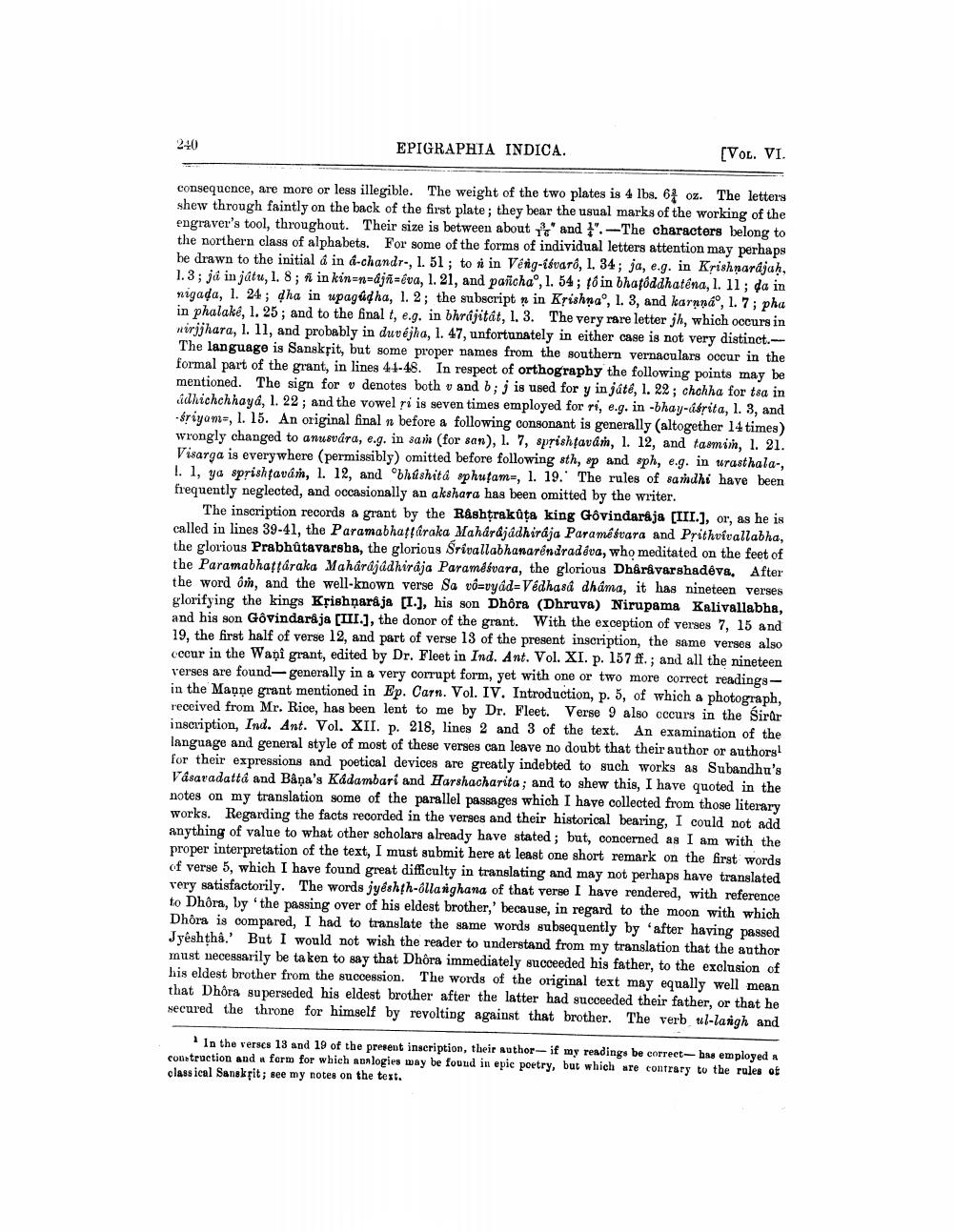________________
240
EPIGRAPHIA INDICA.
[VOL. VI.
consequence, are more or less illegible. The weight of the two plates is 4 lbs. 64 oz. The letters shew through faintly on the back of the first plate; they bear the usual marks of the working of the engraver's tool, throughout. Their size is between about it and ". -The characters belong to the northern class of alphabets. For some of the forms of individual letters attention may perhaps be drawn to the initial á in a-chandr., 1. 51; to si in Véng-isvaró, 1, 34; ja, e.g. in Krishnarajah, 1.3; ja in játu, 1. 8; ñ in kin=n=djn-éva, 1.21, and pancha", 1. 54; tô in bhatóddhatena, l. 11; da in nigada, 1. 24; dha in upagüdha, 1. 2; the subscript » in Krishna', 1.3, and karnná, 1. 7; pha in phalaké, 1. 25; and to the final t, e.g. in bhrajitát, 1. 3. The very rare letter jh, which occurs in wirjjhara, 1. 11, and probably in duvéjha, 1. 47, unfortunately in either case is not very distinct.The language is Sanskrit, but some proper names from the southern vernaculars occur in the formal part of the grant, in lines 41-48. In respect of orthography the following points may be mentioned. The sign for v denotes both v and b; j is used for y in játé, 1. 22; chchha for tsa in udhichchhaya, 1. 22; and the vowel ri is seven times employed for ri, e.g. in -bhay-usrita, 1. 3, and -śriyams, 1. 15. An original final n before a following consonant is generally (altogether 14 times) wrongly changed to anusvára, e.g. in sam (for san), 1. 7, sprishtarán, 1. 12, and tasmin, 1. 21. Visarga is everywhere (permissibly) omitted before following sth, sp and sph, e.g. in trasthala, I. 1, ya sprishtavan, l. 12, and bhúshità sphufams, 1. 19. The rules of samdhi have been frequently neglected, and occasionally an akshara has been omitted by the writer.
The inscription records a grant by the Rashtrakůta king Gôvindaraja [III.], or, as he is called in lines 39-41, the Paramabhaffaraka Maharajadhiraja Parametrara and Prithvivallabha, the glorious Prabhutavarsha, the glorious Srivallabhanarendradeva, who meditated on the feet of the Paramabhatfaraka Maharajadhiraja Paramèsvara, the glorious Dhåråvarshadêve. After the word om, and the well-known verse Sa rôzvyád=Védhasa dháma, it has nineteen verses glorifying the kings Kpishnaraja [I.], his son Dhôra (Dhruva) Nirupama Kalivallabha, and his son Gôvindaraja [III.], the donor of the grant. With the exception of verses 7, 15 and 19, the first half of verse 12, and part of verse 13 of the present inscription, the same verses also occur in the Waņi grant, edited by Dr. Fleet in Ind. Ant. Vol. XI. p. 157 ff.; and all the nineteen verses are found-generally in a very corrupt form, yet with one or two more correct readingsin the Manne grant mentioned in Ep. Carn. Vol. IV. Introduction, p. 5, of which a photograph, received from Mr. Rice, has been lent to me by Dr. Fleet. Verse 9 also occurs in the Sirar inscription, Ind. Ant. Vol. XII. p. 218, lines 2 and 3 of the text. An examination of the language and general style of most of these verses can leave no doubt that their author or authors! for their expressions and poetical devices are greatly indebted to such works as Subandhu's Vasaradatta and Båņa's Kadambari and Harshacharita; and to shew this, I have quoted in the notes on my translation some of the parallel passages which I have collected from those literary works. Regarding the facts recorded in the verses and their historical bearing, I could not add anything of value to what other scholars already have stated; but, concerned as I am with the proper interpretation of the text, I must submit here at least one short remark on the first words of verse 5, which I have found great difficulty in translating and may not perhaps have translated very satisfactorily. The words jyéshth-ollarghana of that verse I have rendered, with reference to Dhôra, by the passing over of his eldest brother,' because, in regard to the moon with which Dhöra is compared, I had to translate the same words subsequently by "after having passed Jyéshtha.' But I would not wish the reader to understand from my translation that the author must necessarily be taken to say that Dhôra immediately succeeded his father, to the exclusion of his eldest brother from the succession. The words of the original text may equally well mean that Dhôra superseded his eldest brother after the latter had succeeded their father, or that he secured the throne for himself by revolting against that brother. The verb ul-langh and
* In the verscs 13 and 19 of the present inscription, their author-if my readings be correct--bns employed construction and form for which analogies way be found in epic poetry, but which are contrary to the rules of classical Sanskrit; see my notes on the text.




